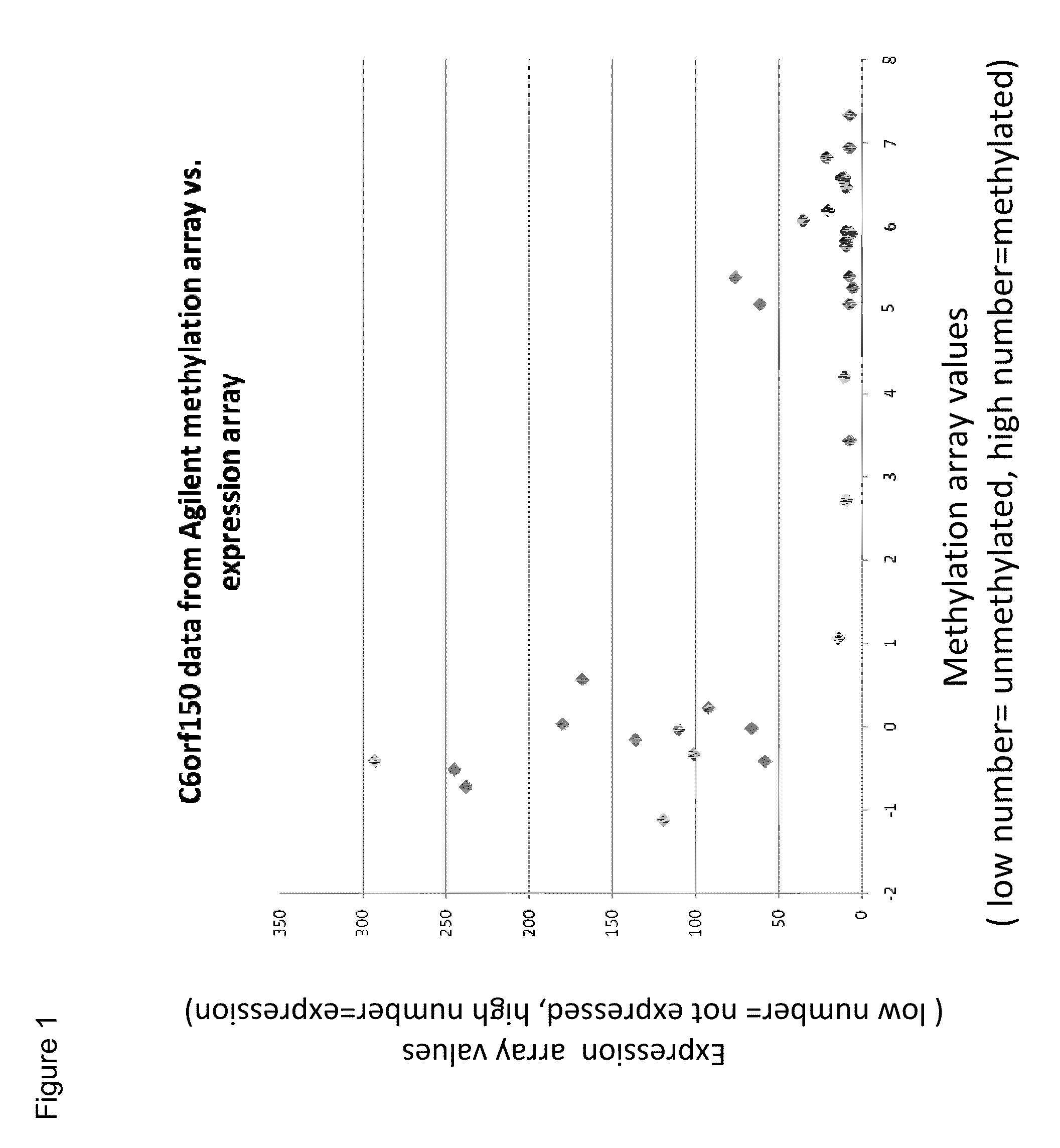Aberrant methylation of C6Orf150 DNA sequences in human colorectal cancer
a methylation and colorectal cancer technology, applied in the field of methylation of c6orf150 dna sequences in human colorectal cancer, can solve the problems of manual rectal examination by a physician, unsatisfactory methods, and 55,000 deaths in the u.s., and achieve high stringent conditions
- Summary
- Abstract
- Description
- Claims
- Application Information
AI Technical Summary
Benefits of technology
Problems solved by technology
Method used
Image
Examples
example 1
C6Orf150 is Methylated and Silenced in Colon Cancer Cell Lines
[0179]The methylation status of the C6Orf150 locus was interrogated using the technique of MCA (Methylation CpG Island Amplification) coupled to CpG island microarray (Estecio MR, et al., High-throughput methylation profiling by MCA coupled to CpG island microarray. Genome Res 2007, 17(10):1529-36; Shen L, et al., Genome-wide profiling of DNA methylation reveals a class of normally methylated CpG island promoters. PLoS Genet 2007, 3(10):2023-36.). In this technique, methylated genomic regions are recognized by resistance to digestion with the methylation sensitive restriction enzyme SmaI. SmaI digestion resistant fragments from tumors and SmaI resistant fragments from normal control are differentially labeled with different fluorescent dyes, and are then compared by co-hybridization to microarrays.
[0180]Table 5 below shows the results of this analysis for the C6Orf150 locus. Numbers in Table 5 represent log 2 of the ratio...
example 2
Methylation Across the C6Orf150 DMR Domain as Assayed by MSP
[0183]The DMR across C6Orf150 was assayed for the presence of methylation by methylation specific PCR (MSP) for a representative subset of methylation specific PCR assays. Samples interrogated include normal colon tissues from patients who do not have colon cancer (Non-Cancer Ns), colon cancer tumors that are unmethyated in other reference colon cancer biomarkers (“UM”), colon cancer tumors that are ambiguous for methylation in other reference colon cancer biomarkers (“?”), and colon cancers that have been shown to be methylated in other biomarkers (“Methylated in other biomarkers”). As shown on FIG. 5, it is obvious that these MSP assays detect much more methylation within the C6Orf150 differentially methylated domain in cancers than in normal tissues. Of particular interest are MSP reactions MSP8, MSP10, and MSP23. These reactions do not detect any methylation within normal colon tissues, but do detect methylation in a su...
example 3
Methylation at the MSP8 Target Region is Sensitive and Specific to Colon Cancer
[0184]As shown in FIG. 9, colon cancer samples with positive MSP8 assays for C6Orf150 methylation turn positive by at least as early as PCR cycle 31. In contrast, normal colon samples remain negative in the assay for as late as at least PCR cycle number 46. FIG. 10 shows assay of 90 cycles of nested PCR for MSP8 (done by repeat PCR for 45 cycles of an aliquot taken from an initial 45 cycle PCR reaction). 90 cycles of nested PCR for MSP8 turns only 1 normal colon sample positive. Therefore, methylation at the MSP8 target region is essentially undetectable in the great majority of normal colon tissues.
[0185]FIG. 11 summarizes the results of C6Orf150 MSP8 testing of a panel of colon cancer cell lines used in the initial array study, and a panel of normal mucosa from 13 individuals without cancer (non-cancer normals), plus a validation set of 154 colon cancer tumor tissues of known Dukes clinical stage and co...
PUM
| Property | Measurement | Unit |
|---|---|---|
| length | aaaaa | aaaaa |
| temperature | aaaaa | aaaaa |
| temperature | aaaaa | aaaaa |
Abstract
Description
Claims
Application Information
 Login to View More
Login to View More - R&D
- Intellectual Property
- Life Sciences
- Materials
- Tech Scout
- Unparalleled Data Quality
- Higher Quality Content
- 60% Fewer Hallucinations
Browse by: Latest US Patents, China's latest patents, Technical Efficacy Thesaurus, Application Domain, Technology Topic, Popular Technical Reports.
© 2025 PatSnap. All rights reserved.Legal|Privacy policy|Modern Slavery Act Transparency Statement|Sitemap|About US| Contact US: help@patsnap.com



